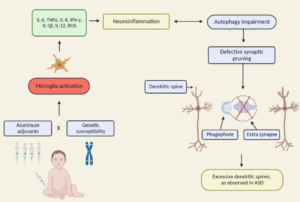Excerpt:
“We propose that children with the autism diagnosis are especially vulnerable to toxic metals such as aluminum and mercury due to insufficient serum sulfate and glutathione. A strong correlation between autism and the MMR (Measles, Mumps, Rubella) vaccine is also observed, which may be partially explained via an increased sensitivity to acetaminophen administered to control fever.”
Abstract
Autism spectrum disorders (ASD) are neurodevelopmental diseases that affect an alarming number of individuals. The etiological basis of ASD is unclear, and evidence suggests it involves both genetic and environmental factors. There are many reports of cytokine imbalances in ASD. These imbalances could have a pathogenic role, or they may be markers of underlying genetic and environmental influences. Cytokines act primarily as mediators of immunological activity, but they also have significant interactions with the nervous system. They participate in normal neural development and function, and inappropriate activity can have a variety of neurological implications. It is therefore possible that cytokine dysregulation contributes directly to neural dysfunction in ASD. Further, cytokine profiles change dramatically in the face of infection, disease, and toxic exposures. Therefore, imbalances may represent an immune response to environmental contributors to ASD. The following review is presented in two main parts. First, we discuss select cytokines implicated in ASD, including IL-1Β, IL-6, IL-4, IFN-γ, and TGF-Β, and focus on their role in the nervous system. Second, we explore several neurotoxic environmental factors that may be involved in the disorders, and focus on their immunological impacts. This review represents an emerging model that recognizes the importance of both genetic and environmental factors in ASD etiology. We propose that the immune system provides critical clues regarding the nature of the gene by environment interactions that underlie ASD pathophysiology.
Abstract
Thimerosal generates ethylmercury in aqueous solution and is widely used as preservative. We have investigated the toxicology of Thimerosal in normal human astrocytes, paying particular attention to mitochondrial function and the generation of specific oxidants. We find that ethylmercury not only inhibits mitochondrial respiration leading to a drop in the steady state membrane potential, but also concurrent with these phenomena increases the formation of superoxide, hydrogen peroxide, and Fenton/Haber-Weiss generated hydroxyl radical. These oxidants increase the levels of cellular aldehyde/ketones. Additionally, we find a five-fold increase in the levels of oxidant damaged mitochondrial DNA bases and increases in the levels of mtDNA nicks and blunt-ended breaks. Highly damaged mitochondria are characterized by having very low membrane potentials, increased superoxide/hydrogen peroxide production, and extensively damaged mtDNA and proteins. These mitochondria appear to have undergone a permeability transition, an observation supported by the five-fold increase in Caspase-3 activity observed after Thimerosal treatment.
Excerpt:
“There was a significant increase in the rates of special education students and autism rates associated with increases in environmentally released mercury. On average, for each 1,000 lb of environmentally released mercury, there was a 43% increase in the rate of special education services and a 61% increase in the rate of autism. The association between environmentally released mercury and special education rates were fully mediated by increased autism rates. “
Results:
By comparing hair concentration of autistic vs nonautistic children, elevated hair concentrations were noted for aluminum, arsenic, cadmium, mercury, antimony, nickel, lead, and vanadium. Hair levels of calcium, iron, iodine, magnesium, manganese, molybdenum, zinc, and selenium were considered deficient. There was a significant positive correlation between lead & verbal communication (p = 0.020) and general impression (p = 0.008). In addition, there was a significant negative correlation between zinc & fear and nervousness (p = 0.022).
Conclusion:
Our data supports the historic evidence that heavy metals play a role in the development of ASD. In combination with an inadequate nutritional status the toxic effect of metals increase along with the severity of symptoms.
Excerpts:
“The current literature suggests an imbalance of oxidative and anti-oxidative stress systems in autism. Glutathione is involved in neuro-protection against oxidative stress and neuro-inflammation in autism by improving the anti-oxidative stress system. Decreasing the oxidative stress might be a potential treatment for autism.”
Excerpt:
“it is now clearly established that there is a bidirectional neuro-immune cross-talk that plays crucial roles in immunoregulation as well as brain function. In turn, perturbations of the neuro-immune axis have been demonstrated in many autoimmune diseases encompassed in “ASIA” and are thought to be driven by a hyperactive immune response; and (iv) the same components of the neuro-immune axis that play key roles in brain development and immune function are heavily targeted by Al adjuvants.”
Excerpt:
“This study suggests that febrile seizures and family history of neuropsychiatric disorders are correlated with autistic regression.”
Excerpt:
‘We conclude that exposure of Hepa1-6 cells to a low dose of adjuvanted hepatitis B vaccine leads to loss of mitochondrial integrity, apoptosis induction, and cell death, apoptosis effect was observed also in C2C12 mouse myoblast cell line after treated with low dose of vaccine (0.3, 0.1, 0.05 μg/ml).”
Excerpt:
“When assessing adjuvant toxicity in children, several key points ought to be considered: (i) infants and children should not be viewed as “small adults” with regard to toxicological risk as their unique physiology makes them much more vulnerable to toxic insults; (ii) in adult humans Al vaccine adjuvants have been linked to a variety of serious autoimmune and inflammatory conditions (i.e., “ASIA”), yet children are regularly exposed to much higher amounts of Al from vaccines than adults; (iii) it is often assumed that peripheral immune responses do not affect brain function. However, it is now clearly established that there is a bidirectional neuro-immune cross-talk that plays crucial roles in immunoregulation as well as brain function. In turn, perturbations of the neuro-immune axis have been demonstrated in many autoimmune diseases encompassed in “ASIA” and are thought to be driven by a hyperactive immune response; and (iv) the same components of the neuro-immune axis that play key roles in brain development and immune function are heavily targeted by Al adjuvants.”
